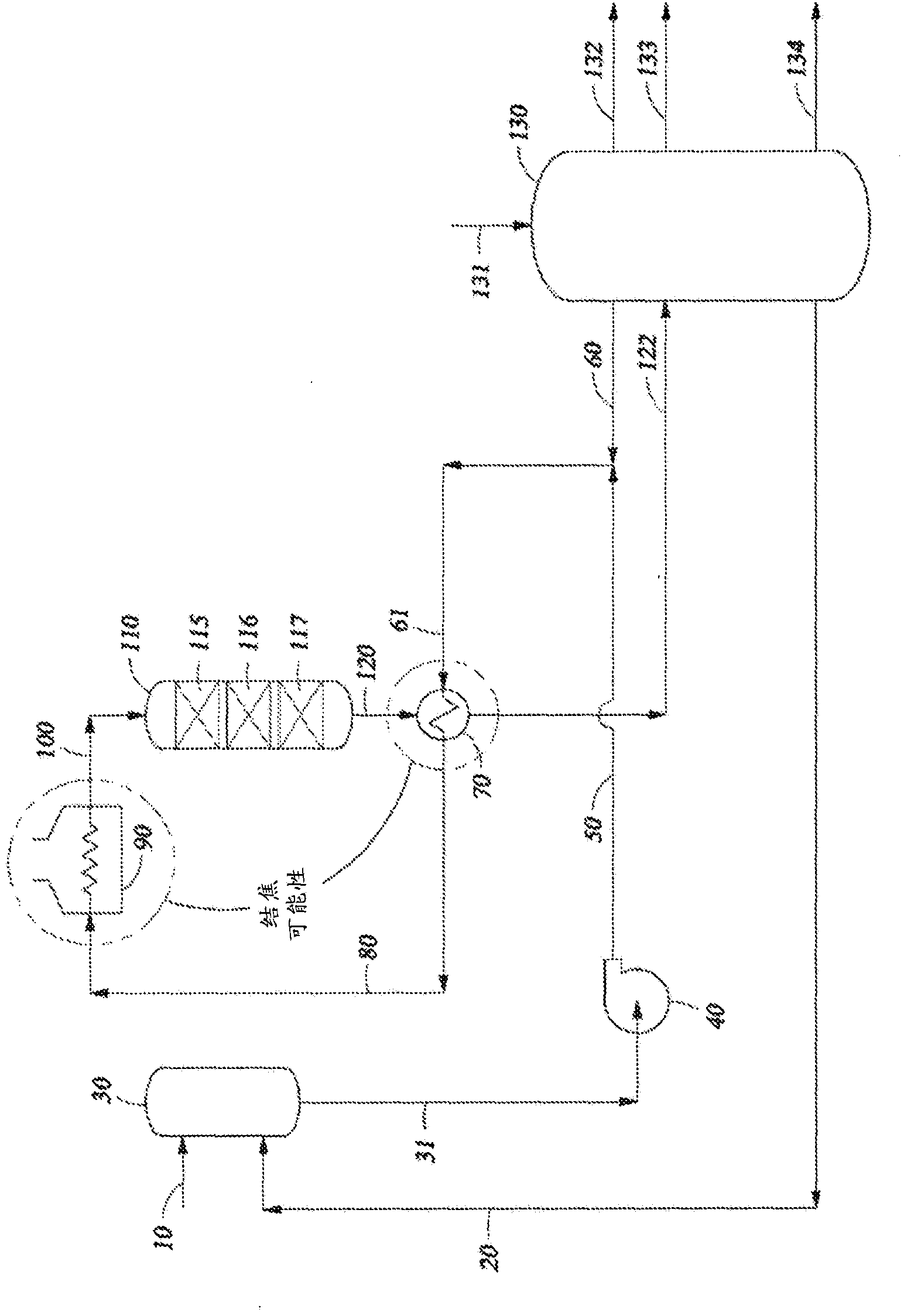Preheating feeds to hydrocarbon pyrolysis products hydroprocessing
A technology for hydrotreating and product, which can be applied in hydrotreating process, treatment with hydrogen compounds, treatment of hydrocarbon oil, etc., and can solve the problems of space velocity promoting hydrogenation reaction, catalyst coking, economic deterioration, etc.
- Summary
- Abstract
- Description
- Claims
- Application Information
AI Technical Summary
Problems solved by technology
Method used
Image
Examples
Embodiment
[0109] Below is in Figure 2-4 Examples of implementation schemes are depicted in the Process simulation software, obtained from Invensys Inc. Process simulation software is a steady-state simulator that can improve process design and calculation analysis. It is designed to implement rigorous mass and energy balance calculations used in many chemical processes. Used for The simulated reactor feed and product characterization are based on boiling point curve (simulated distillation GC, ASTM D2887) and density from experimental data.
[0110] For all examples, refer to figure 1 , 2 , 3, 4, the separation section 130 represents conventional separation equipment for hydroprocessing, including high-temperature and low-temperature separators, stabilization towers, deacidified gas, and auxiliary equipment such as heat exchangers and recycle gas compressors. Optionally, separation of light fuel and heavy fuel oil is provided to prepare two hydrotreated products. The light fuel oil is...
Embodiment 2
[0115] figure 2 An embodiment is depicted in which a lower temperature first reactor section is used to minimize the risk of coking and fouling in the reactor preheating sequence. This embodiment uses the first lower temperature section 110 in the hydrotreating reactor to apply higher activity catalysts such as Nebula20Criterion DN3651, DN3551 or Albermarle KF860 so that the first reactor section feed 54 is only heated to 600°F (375°C) . The first stage reactor effluent 55 reached 611°F (322°C). Here, however, the most active precursors for coking (asphaltenes, cyclodienes, vinyl aromatics, olefins, dienes, oxygenates) have been hydrotreated. Then the first stage reactor effluent 55 is heated to 742°F (394°C) in the feed preheating heat exchanger 70 and heated to the second stage reactor inlet temperature of 750°F (400°C) by the preheater 90 ). The second stage reactor 111 contains two RT-621 catalyst beds 116,117.
Embodiment 3
[0117] image 3 An embodiment is depicted in which the SCT feed surrounds the reactor feed / effluent heat exchanger 70 and reactor feed adjustment heater 90. In this example, the SCT feed stream 50 is at 534°F (279°C). Hydrogen 60 and utility fluid 20 are mixed and directed to the feed side of reactor feed / effluent heat exchanger 70 and heated to 780°F (415°C) versus 804°F (429°C) reactor effluent 120. The heating stream 80 is then directed to the reactor feed adjustment heater 90 and heated to 940°F (504°C). This 940°F (504°C) hot mixture 91 is then mixed with 534°F (279°C) SCT50 and the entire mixture 100, now at the required reactor inlet temperature of 750°F (400°C), enters the reactor 110.
PUM
| Property | Measurement | Unit |
|---|---|---|
| particle size | aaaaa | aaaaa |
| melting point | aaaaa | aaaaa |
| density | aaaaa | aaaaa |
Abstract
Description
Claims
Application Information
 Login to View More
Login to View More - R&D
- Intellectual Property
- Life Sciences
- Materials
- Tech Scout
- Unparalleled Data Quality
- Higher Quality Content
- 60% Fewer Hallucinations
Browse by: Latest US Patents, China's latest patents, Technical Efficacy Thesaurus, Application Domain, Technology Topic, Popular Technical Reports.
© 2025 PatSnap. All rights reserved.Legal|Privacy policy|Modern Slavery Act Transparency Statement|Sitemap|About US| Contact US: help@patsnap.com



